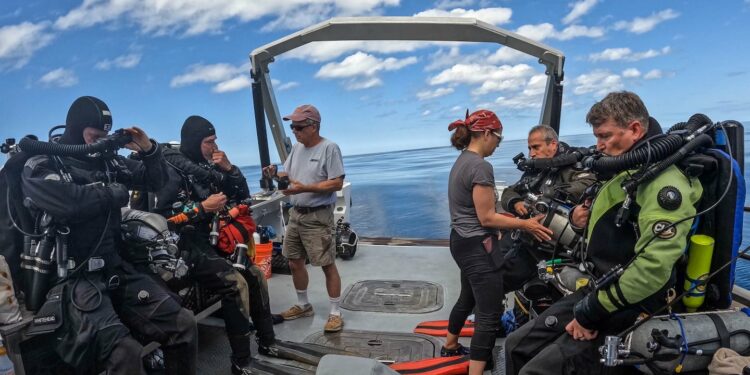For nearly 170 years, Le Lyonnais lay at the bottom of the Atlantic Ocean, though no one knew exactly where. Until last month, when a dive team found its wreckage about 200 miles off the Massachusetts coast.
“We always have kind of a list of ships that we’re looking for, but this one became a passion project for us over the last eight years,” Jennifer Sellitti said.
Sellitti, 50, and her partner, Joe Mazraani, live in New Jersey, where they are “lawyers by day and shipwreck hunters on the weekend,” operating Atlantic Wreck Salvage LLC and the vessel D/V Tenacious, Sellitti said.
The team from Atlantic Wreck Salvage prepared for a dive. From left were Tim Whitehead, Tom Packer, Eric Takakjian, Jennifer Sellitti, Joe Mazraani, and Andrew Donn.Atlantic Wreck Salvage LLC
Sellitti, formerly a staff attorney for the Committee for Public Counsel Services in Massachusetts, became interested in Le Lyonnais in 2016 after she asked Mazraani to suggest a missing ship she could look into.
“I very quickly just became obsessed with this ship, and her story,” she said. “And every little piece of information I uncovered was this sort of this unraveling of what really is an incredible story about this collision.”
Contemporary accounts describe an avoidable tragedy. Different reports include varying numbers of people on board, but Sellitti’s research indicates 114 of 132 passengers and crew members died.
An 1856 report in The New York Times said the collision took place “in a thick fog.” The Adriatic’s captain, Jonathan Durham, initially expected Le Lyonnais would miss his ship, but after a light on the Adriatic was accidentally snuffed and relit, he saw that Le Lyonnais “had changed her course and was coming directly toward the [Adriatic].”
The Times report said Le Lyonnais kept going after the collision “and was almost immediately out of sight in the fog.” Durham told the Times his crew “hailed the steamer, and requested them not to leave us, but received no answer.”
After those aboard Le Lyonnais abandoned ship for lifeboats and a makeshift raft, the “weather was very rough, and the hapless voyagers suffered terribly,” according to The Maitland Mercury and Hunter River General Advertiser of New South Wales, Australia.
“They encountered several severe snowstorms, and were short of water,” the paper reported, according to survivors’ accounts. “They had claret, bread and preserved meats. They were beaten about six days, until the afternoon of the 9th (Sunday), and two of their number (passengers) died during this terrible interval.”
The Adriatic, which had been bound for Savannah, Ga., instead went to Gloucester, Mass., for repairs, arriving“in distress” on Nov. 4.
Durham was later apprehended in France and put on trial there for the collision, according to Sellitti, who has written a forthcoming book called “The Adriatic Affair: A Maritime Hit-and-Run off the Coast of Nantucket.”
Joe Mazraani wiped away sand to reveal a “deadeye” used as part of Le Lyonnais’s sail rigging.Andrew Donn
To find Le Lyonnais, the team combined what Sellitti learned from her research with information about anomalies on the ocean floor, which initially came from speaking with fishermen who work in the area, she said. Later, the team used sonar to scan the depths and then began diving toexplore the unknown bumps and masses they were finding.
“A shipwreck so old is like a needle in a haystack,” Sellitti said. “Back in the 1800s, they measured speed by dropping a rope with knots into the water. That’s where we get the name ‘knots’ from. They used stars for navigation. . . . They didn’t report positions the same way modern ships report positions.”
Assisting in the search was Captain Eric Takakjian, who had begun looking for Le Lyonnais almost a decade earlier. Takakjian said the ship is significant because it comes from a transitional period in seafaring.
“Her iron hull construction methods represented some of the earliest examples of that type of hull construction for oceangoing ships known to exist,” he said in a statement. “Similarly, her propulsion machinery is unique in that it represents one of several engine designs that were tried before precedents were set on ocean steamship machinery.”
The search required Mazraani and Sellitti to rebuild their boat so it could travel greater distances and involved painstaking scans of the ocean floor, which the team called “mowing the lawn.”
Last month, their dive crew spent five days in the water examining a handful of potential wreck sites, “and one of those turned out to be it,” Sellitti said.
“I wish I could say there’s one ‘aha’ moment,” she said. “This was a lot of little things that were adding up.”
A portion of Le Lyonnais’s engine cylinder.Andrew Donn
The crew found portholes consistent with 1850s shipbuilding and other promising wreckage, but Sellitti became convinced they had found Le Lyonnais when they examined the steam engine cylinder, a type that was used only briefly and measured 57 inches — the size records showed for Le Lyonnais’s engine.
Then, during Mazraani’s final dive on Aug. 25, he found rigging that showed the ship had sails as well as the engine, Sellitti said.
“That was when we felt like we could say to the world that we had found it,” she said.
Sellitti and Mazraani aren’t revealing the ship’s exact position because they plan to continue dives and hope to learn more about the ship’s final hours from the debris.
“We’re going to have years of exploring this,” Sellitti said. “Once storms come over the winter, they might bury parts of it and expose other parts of the wreck. So we’ll be going back every summer to continue to document it and explore it.”
Joe Mazraani, Eric Takakjian, and Tom Packer reviewed video of the ocean floor between dives.Atlantic Wreck Salvage LLC
Jeremy C. Fox can be reached at [email protected]. Follow him @jeremycfox.
Source link : http://www.bing.com/news/apiclick.aspx?ref=FexRss&aid=&tid=66dc26cb78384df78077fc57ecd1347f&url=https%3A%2F%2Fwww.bostonglobe.com%2F2024%2F09%2F07%2Fmetro%2Fship-sank-1856-found-massachusetts%2F&c=4436761021748271858&mkt=en-us
Author :
Publish date : 2024-09-06 23:00:00
Copyright for syndicated content belongs to the linked Source.







